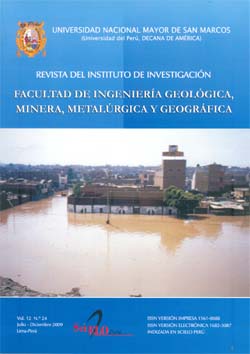Cutters perfomance in Tunnel Boring Machines according to position on the Cutterhead
DOI:
https://doi.org/10.15381/iigeo.v12i24.367Keywords:
Tunnel Boring Machine, TBM, disc cutters, center cutter, face cutter, gauge cutters, cutterheadAbstract
The cutters in general are the essential elements to crush, break and move to the rock during an excavation. In particular case of the tunnel boring machines (TBM), the disc cutters play a preponderant role since the attack to the rock takes place only by compression and rotation of the cutterhead that carries the cutters. The present research was carried out during the excavation of the Nº 4 headrace tunnel of the Yuncan hydroelectric project (Paucartambo II), located in Paucartambo district, Pasco province and department, where applied the MK 12 Atlas Copco Jarva TBM, that has 4.10 m cutterhead diameter provided with 27 disc cutters. From the pursuit of the cutters, its life in meters of excavated tunnel could be verified that, depends on its position in the mall pillow of a TBM, independent of the type of rock. It was possible to be demonstrated that the reinforcements (gauge cutters) are those of greater wearing down, followed by the frontals (phase cutters) and being of greater duration the power stations (to center to cutter).
Downloads
Published
Issue
Section
License
Copyright (c) 2009 Mauro Giraldo Paredez, Oswaldo Ortiz Sánchez, Wilfredo Blas Guzmán

This work is licensed under a Creative Commons Attribution-NonCommercial-ShareAlike 4.0 International License.
AUTHORS RETAIN THEIR RIGHTS:
a. Authors retain their trade mark rights and patent, and also on any process or procedure described in the article.
b. Authors retain their right to share, copy, distribute, perform and publicly communicate their article (eg, to place their article in an institutional repository or publish it in a book), with an acknowledgment of its initial publication in the Rev. Inst. investig. Fac. minas metal cienc. geogr.
c. Authors retain theirs right to make a subsequent publication of their work, to use the article or any part thereof (eg a compilation of his papers, lecture notes, thesis, or a book), always indicating the source of publication (the originator of the work, journal, volume, number and date).






